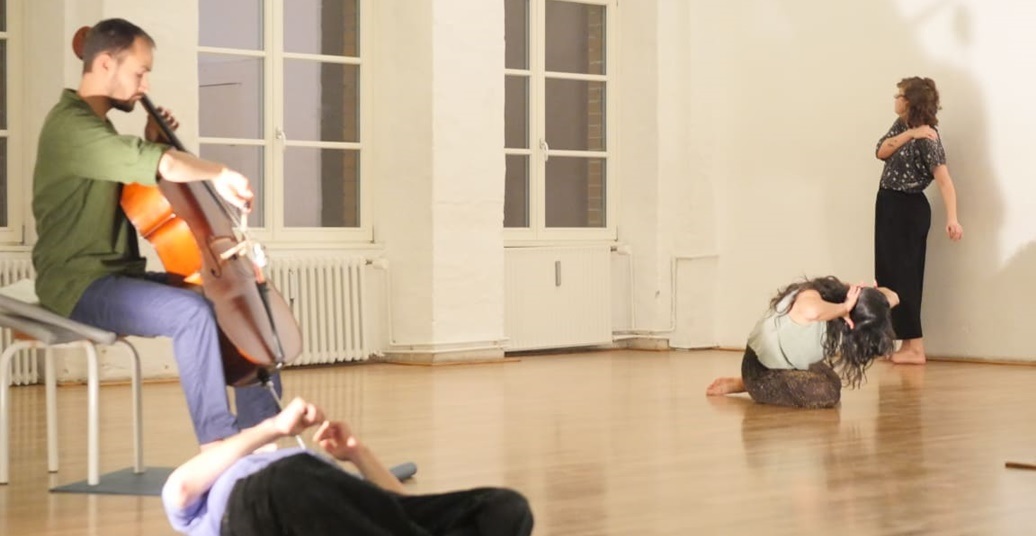Three improvisations between musicians and dancers at the monthly Common Ground series provide different approaches to instant composition.
Berlin is host to a number of events each considering the relationship between music and dance. DOCK 11’s “SOUNDANCE” summer festival pairs up musicians and dancers for creative collaborations, while wintertime’s “LABOR SONOR: Choreographing Sound” sees dancers perform compositions, and composers collaborate with performers to create physical, visual pieces. Ancestor to these festivals was “nichts wissen um fünf”, which was started by Heide Moldenhauer, Sten Rudström, and Ingo Reulecke in 2000. The series faded, but was restarted three years ago, with Reulecke as chief curator and organizer, and now takes place on the first Sunday of each month at the historic digs of Tanzfabrik Kreuzberg. The goal for Reulecke, who re-dubbed the series “Common Ground”, is to find a synthesis between sound and music with movement and dance in the frame of instant composition. At the end of each set of performances event there is an after-talk (or, more precisely, a sort of conversational sharing circle) in which the artists and audience discuss how the works were prepared, what they saw, and the artists’ goals for the improvisations.
The evening I attend, a series of three instant compositions take place. The first is organized and performed by Ayam with cellist Gábor Hartyáni, percussionist Wieland Möller, and dancers Kajsa Josefin Nilsson and Saša Pavić. The composition begins with two musicians, pinned at opposite corners. Between them sits a bright light directed away from the audience toward the white wall, so that when the three dancers, crouched amongst the audience members, finally enter, their shadows loom large. The dancers bodies move in and out of each other’s orbits, their shadows fluttering against the wall—Ayam and Nilsson in particular are luxuriously fluid in their movement.
Ayam’s stated interest here is in how instant composition allows an investigation into and exposition of how individuals function within a whole, how the dancers can echo or respond to one another’s emotional (and not only physical) worlds. I ask Ayam how she deals with the challenges she set herself and her collaborators in this particular composition, and, in keeping with her holistic approach to her work, she answers that she deals with the questions she poses in her work “not only as an artist, but as a woman, mother, person, being.” Such a vague statement is hard to feel enlightened by, and yet, as Ayam’s team twirls spectrally between the two poles of the oppositional positioned musicians, like clouds on a picture of Earth from outerspace, amidst sounds of music, rapt audience attention, and her child calling to her periodically from the side, there is something both very much of the everyday and of the spiritual about her offering.
The second instant composition is created by dancer Jasmnka Stenz and musician Dustin Zorn. In stark contrast to Ayam, Stenz and Zorn begin with low lighting, and the rumble of radio from stage right. “The idea,” Stenz writes me later, “was to use the radio as a common ground for us… We all know the radio, we all know that it is unpredictable in the first place [as regards] what comes next, and that’s what inspired me to work with it”. Therefore, she explains, the unpredictability situates not only the artistic collaborators in a common ground, but the audience and the artists on a similarly unfamiliar playing field. Zorn “plays”, viz. channels, the radio live, as frequencies, static, words, and music come and go. Stenz, who acknowledges and builds on the work’s Cageian heritage , responds to the sounds. Her generally pedestrian vocabulary finds punctuated emphasis in her business-casual attire, a nice and refreshing change from the familiar flowing clothes of instant composition. “The radio is a very challenging instrument: music is very dominant in the space, and if a song that I do not like [comes on], that I do not feel inspired by, I have to deal with that”. Indeed the challenges are rife, and not all I appreciate as much as others: the dim lighting for more than half of the piece makes it difficult to see as much as I would appreciate, and the confused ending has the whiff of Zorn getting carried away with the radio, rather than the relationality between the two artists and the audience which Stenz proposes.
The third offering is from Maria Rutanen, who works with cellist Gábor Hartyáni, and performs herself alongside dancer Sara Paternesi. Rutanen and Hartyáni have only improvised together once before, and the three of them had not had the chance to come together before the event, so their collaboration was truly fresh. Rutanen tells me that initially she was very occupied with thinking about the sound, deciding how to use it, how much space and silence to give. Rutanen and Hartyáni often found their improvisational processes, which involved talking while improvising (a feature not present in their public presentation), most satisfying when warming up, rather than when trying to accomplish a particular goal, and therefore decided that their performance would be a similar kind of playful “warm-up”. And yet—or perhaps because of this—a particularly fine example of impulse, listening, and balance. All three listen with engagement, inventively offer propositions, and use the architectural space admirably; Paternesi brings an especially taut and elegant form of movement to the trio.
Like Ayam, Rutanen also wonders about how the co-existence of multiple agents does and might work. “Balance,” she tells me, “is the ongoing movement between individual freedom and group… I want to see people solving the problems they created. I am interested in how are they working with each other, dealing with uncertainty. I want to see when people challenge themselves, take risks, question what they are actually doing. How they do it is more important than what. Good improvisation is where the performers are not just filling time and space, but where there is strong listening about what is needed in a particular moment.”
Such thoughtfulness—spoken and embodied—about instant composition in a regular format can only be good for the city. “Berlin,” Reulecke writes me, “has a huge pool of highly professional musicians and performers. I have a seemingly inexhaustible resource from which to find artists and bring them together.” Let the games continue.




